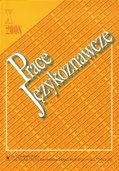Wiek zwierząt jako czynnik determinujący sposób
ich konceptualizacji
Animal age as a factor that determines the way they are conceptualised
Author(s): Beata ZiajkaSubject(s): Theoretical Linguistics, Applied Linguistics
Published by: Wydawnictwo Uniwersytetu Warmińsko-Mazurskiego w Olsztynie
Keywords: linguistics; folk lexis; valuating; conceptualisation
Summary/Abstract: The objective of the article is presenting the way villagers conceptualise animals in termsof their life phase, as reflected in their lexis. The analysis of the animal vocabulary collectedduring field research in selected villages of Lesser Poland (Małopolska) indicatesthat the age factor significantly determines the way animals are perceived and valued.In the acts that value the animal world, the villagers’ practical point of view is visible, as they often evaluate animals in terms of their usefulness which often depends on theage. The influence of the temporal aspect is especially noticeable in the category of “thenames of young animals” which is internally diversified. The category includes severalsemantic sub-categories that correspond to particular phases of the development of immatureanimals. Detailed specification of the age of young animals has a pragmatic basis– it results from the need to specify a turning point which often determines the changein the animal’s function. While the vocabulary related to young animals is positive,the animal lexis communicating semantic content concerning their old age is usuallydepreciating. Thus, adopting the temporal perspective in the interpretation of animalvocabulary is strictly related to the axiological context, which is particularly reflected inthe binary opposition of old-young.
Journal: Prace Językoznawcze
- Issue Year: 21/2019
- Issue No: 4
- Page Range: 235-251
- Page Count: 16
- Language: Polish

